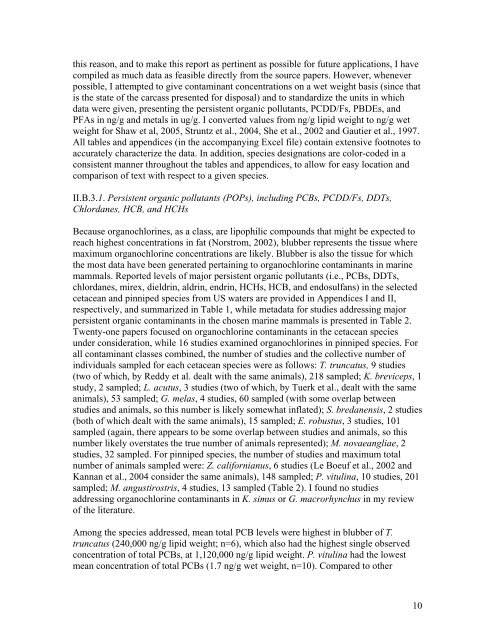Volume III, Appendices EM - National Marine Fisheries Service ...
Volume III, Appendices EM - National Marine Fisheries Service ...
Volume III, Appendices EM - National Marine Fisheries Service ...
Create successful ePaper yourself
Turn your PDF publications into a flip-book with our unique Google optimized e-Paper software.
this reason, and to make this report as pertinent as possible for future applications, I have<br />
compiled as much data as feasible directly from the source papers. However, whenever<br />
possible, I attempted to give contaminant concentrations on a wet weight basis (since that<br />
is the state of the carcass presented for disposal) and to standardize the units in which<br />
data were given, presenting the persistent organic pollutants, PCDD/Fs, PBDEs, and<br />
PFAs in ng/g and metals in ug/g. I converted values from ng/g lipid weight to ng/g wet<br />
weight for Shaw et al, 2005, Struntz et al., 2004, She et al., 2002 and Gautier et al., 1997.<br />
All tables and appendices (in the accompanying Excel file) contain extensive footnotes to<br />
accurately characterize the data. In addition, species designations are color-coded in a<br />
consistent manner throughout the tables and appendices, to allow for easy location and<br />
comparison of text with respect to a given species.<br />
II.B.3.1. Persistent organic pollutants (POPs), including PCBs, PCDD/Fs, DDTs,<br />
Chlordanes, HCB, and HCHs<br />
Because organochlorines, as a class, are lipophilic compounds that might be expected to<br />
reach highest concentrations in fat (Norstrom, 2002), blubber represents the tissue where<br />
maximum organochlorine concentrations are likely. Blubber is also the tissue for which<br />
the most data have been generated pertaining to organochlorine contaminants in marine<br />
mammals. Reported levels of major persistent organic pollutants (i.e., PCBs, DDTs,<br />
chlordanes, mirex, dieldrin, aldrin, endrin, HCHs, HCB, and endosulfans) in the selected<br />
cetacean and pinniped species from US waters are provided in <strong>Appendices</strong> I and II,<br />
respectively, and summarized in Table 1, while metadata for studies addressing major<br />
persistent organic contaminants in the chosen marine mammals is presented in Table 2.<br />
Twenty-one papers focused on organochlorine contaminants in the cetacean species<br />
under consideration, while 16 studies examined organochlorines in pinniped species. For<br />
all contaminant classes combined, the number of studies and the collective number of<br />
individuals sampled for each cetacean species were as follows: T. truncatus, 9 studies<br />
(two of which, by Reddy et al. dealt with the same animals), 218 sampled; K. breviceps, 1<br />
study, 2 sampled; L. acutus, 3 studies (two of which, by Tuerk et al., dealt with the same<br />
animals), 53 sampled; G. melas, 4 studies, 60 sampled (with some overlap between<br />
studies and animals, so this number is likely somewhat inflated); S. bredanensis, 2 studies<br />
(both of which dealt with the same animals), 15 sampled; E. robustus, 3 studies, 101<br />
sampled (again, there appears to be some overlap between studies and animals, so this<br />
number likely overstates the true number of animals represented); M. novaeangliae, 2<br />
studies, 32 sampled. For pinniped species, the number of studies and maximum total<br />
number of animals sampled were: Z. californianus, 6 studies (Le Boeuf et al., 2002 and<br />
Kannan et al., 2004 consider the same animals), 148 sampled; P. vitulina, 10 studies, 201<br />
sampled; M. angustirostris, 4 studies, 13 sampled (Table 2). I found no studies<br />
addressing organochlorine contaminants in K. simus or G. macrorhynchus in my review<br />
of the literature.<br />
Among the species addressed, mean total PCB levels were highest in blubber of T.<br />
truncatus (240,000 ng/g lipid weight; n=6), which also had the highest single observed<br />
concentration of total PCBs, at 1,120,000 ng/g lipid weight. P. vitulina had the lowest<br />
mean concentration of total PCBs (1.7 ng/g wet weight, n=10). Compared to other<br />
10
















